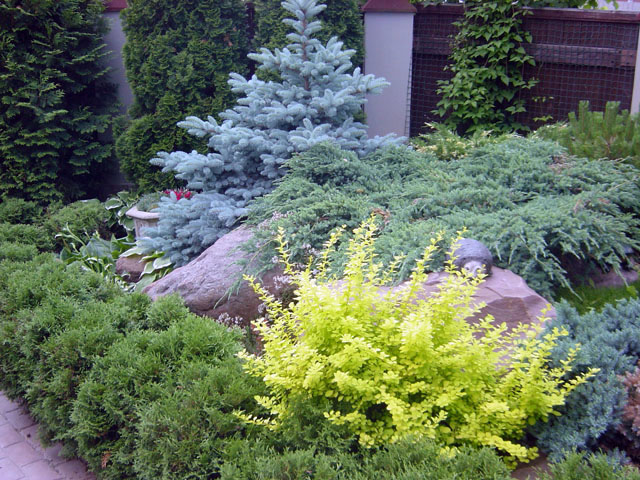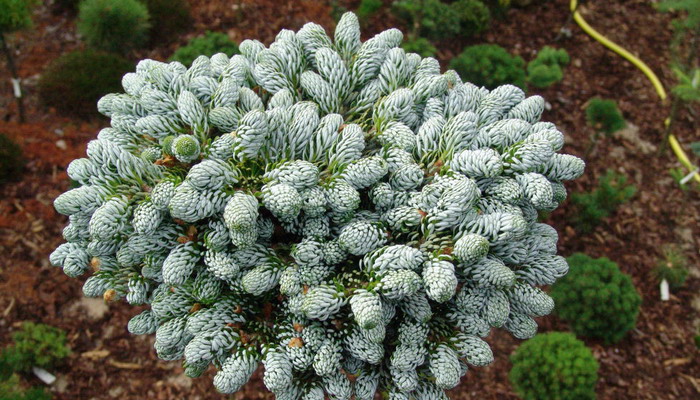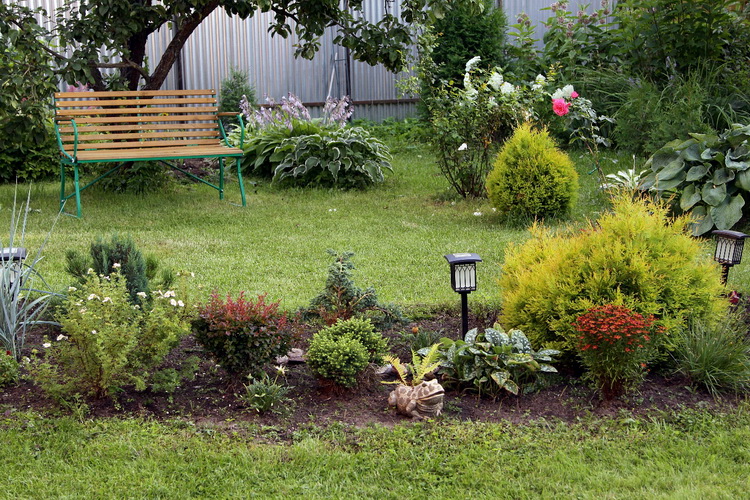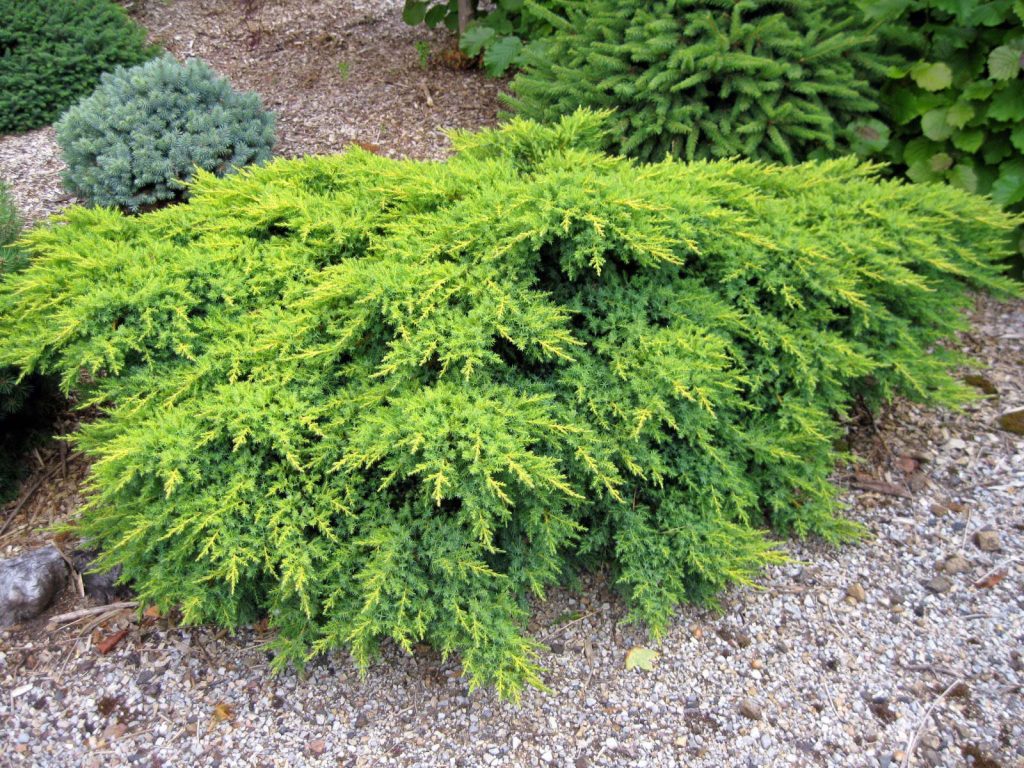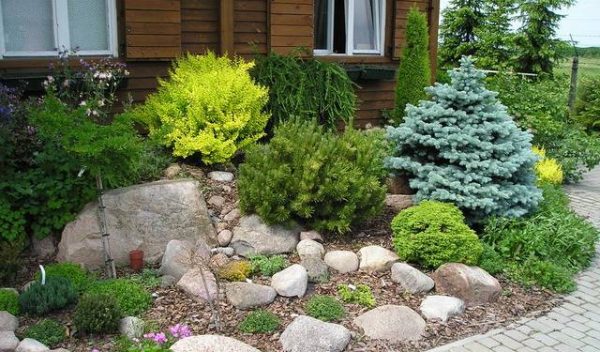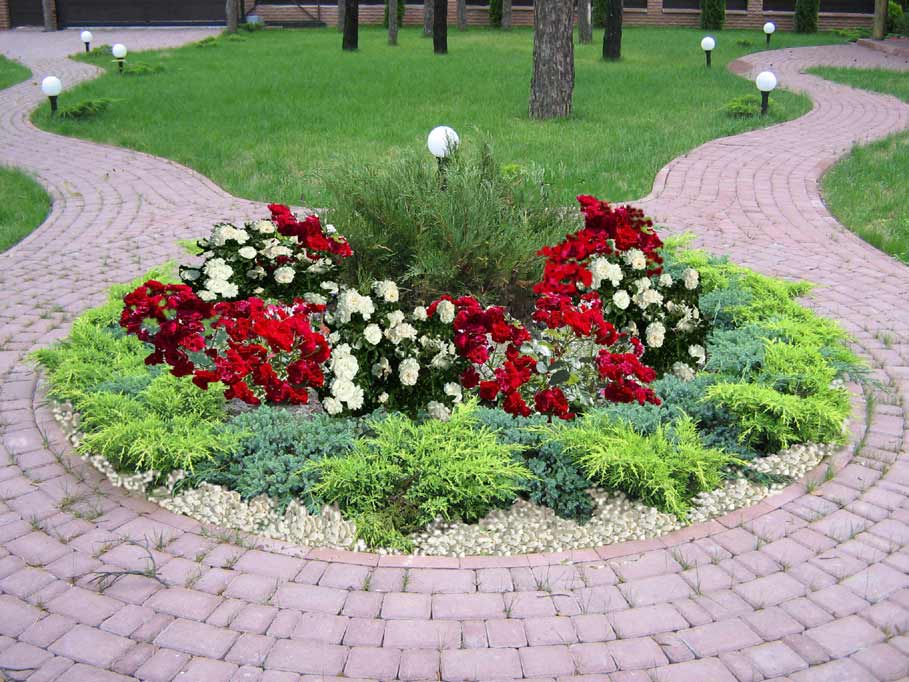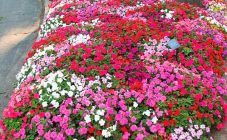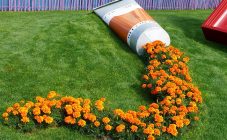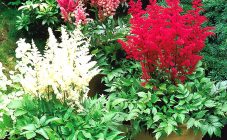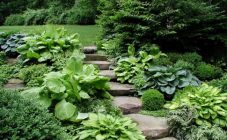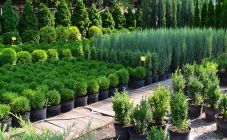Content:
Conifers on the site look attractive, especially if they are compositionally decorated. A bed of conifers is suitable for summer residents who rarely visit the garden plot. Evergreen shrubs are unpretentious. Moreover, they are centenarians. For gardeners who are constantly in the garden, a flower bed with conifers and flowers is suitable. Ornamental green plants look spectacular along with bright roses and other perennials.
Basics of landscape architecture
Not everyone can hire a designer who decorates a garden competently. However, even a novice gardener can take up the aesthetic appearance of the site. In order to independently make the territory harmonious and comfortable, you need to know the main points of landscape architecture. Among them:
- Simplicity and unity;
- Proportionality;
- Balance and Repetition;
- Symmetry.
Simplicity and unity
The garden design should be light and unobtrusive. The more elements and heaps there are, the more sloppy and chaotic the territory looks. Noble simplicity saves budget. Such a garden does not need extra details and decorations.
Proportionality
The principle of proportionality states that it is important to pay attention to the size of the garden itself and the compositions inside. The owner of a small house and garden will not be comfortable going out into the garden, half of which is occupied by a large sculpture or several large and too tall trees. In this case, the already modest territory is visually reduced.
Balance and repetition
Keeping a balance will help make your garden comfortable. You should not plant a small area with trees around the entire perimeter, the balance here will be disturbed due to the appearance of a closed space. Also, the balance will be disturbed if there is a small fence in the garden, along which dwarf bushes are planted. In this case, the owners of the garden will feel uncomfortable, as there will be a feeling that they are on public display. Repetition also affects balance. Balance and structure are created by some repetitive attributes. For example, when decorating a flower garden, a stone is used, and exactly the same material decorates the foundation of a building or a curb by the path.
Symmetry
It's not that the halves of the garden should be symmetrical. However, some similarity and proportionality must be observed.
The principles of forming coniferous beds
There are special principles of landscape design that are recommended to be followed when growing coniferous flower beds:
- The principle of proportionality must be observed when arranging coniferous mixborders. Due to their bulk, they should be located at a sufficient distance from the living and recreation areas. It is necessary to approximately find out the possible volume of the composition, and then increase this number by 2.The resulting result is the answer to the question: "at what distance from the house or gazebo should a flowerbed with conifers and flowers or a coniferous mixborder be located?"
- A flower bed with juniper, thuja, fir, larch will look attractive if there is a pond a few meters away. Home water bodies are often formed by sedge, fern, astilbe, as well as bushes with variegated leaf color, which are called the host. These plants are ideally combined with conifers. Therefore, the pond will look like a coniferous flower bed in the same style.
- A flower garden of evergreen shrubs and compact trees is best planted so that it faces the east or west side. Thus, the plants will receive the required amount of sunlight, but ultraviolet light will not harm them. Plants will always have the opportunity to be where the shadow is.
- The gardener should try to make the inhabitants of the evergreen corner comfortable. Consideration should be given to the slow growth of plants. It is recommended to plant one medium-sized ephedra or two dwarfs on one square meter. To fill the remaining space before the flowerbed takes on its intended appearance, planting annuals or greenery with beautiful leaves is suitable.
Conifers and flowers perennials for mixborder
The following conifers are suitable for creating an evergreen flower garden:
- Veres (juniper);
- Thuja;
- Fir;
- Dwarf pine;
- Blue spruce;
- Yew, etc.
Veres comes in many species and varieties. The most acceptable species for the garden are Cossack, horizontal, ordinary. It is better for a gardener to select undersized and dwarf varieties. For example, the cushion variety Blue Star (its height is only 10 cm, it grows up to 1.7 m in diameter, the needles are silvery); creeping Blue Carpet (grows up to 70 cm in height, about 1.6 m in diameter, blue needles); Echeniformis (semicircular shrub with gray-blue needles, 60 cm high, crown diameter 90-100 cm), etc.
Thuja is indispensable for a mixborder, since its main feature is that the lush crown is easy to cut. Green figures and various architectural forms are made from thuja. The Danika variety is popular (a dwarf with soft scaly needles). The Hoseri variety has a description of the bush in the form of an emerald ball.
A dwarf fir for the composition is selected. For example, the Brilliant variety, which is a round compact bush with delicate needles. An adult 10-year-old plant stretches up to 50 cm in height and 50-70 in width. A few more dwarf firs: Oberon, Silberlock, Nana (balsamic).
Among the varieties of dwarf pines stand out: Mugus with flattened branches, Pumilio and Pug, with crowns in the form of a sphere.
Blue spruce can be a great addition to a mixborder. Especially compact varieties - Glauka Globoza, Montgomery, Lucky Strike, as well as medium-height varieties - Koster, Oldenburg, Edith.
Yew attracts designers with its reddish bark and light green crown. In early summer, noticeable scarlet or reddish-brick berries appear on the plant. All varieties of culture are poisonous. Designers distinguish the varieties Samergold (with golden needles), Elegantissima (with light green-whitish crown).
Perennial plants for the coniferous mixborder are selected with similar preferences for the quality of the soil composition. They combine well and take root with the conifers of culture:
- Barberry;
- Dwarf birch trees;
- Fieldfare;
- Roses;
- Hydrangeas;
- Rhododendrons;
- Heather;
- Erika;
- Thyme;
- Phlox, etc.
Coniferous plant bed
Growing conifers in the form of a flower bed begins with the selection of a place and drawing up a plan or diagram. The place should be sunny. The diagram includes the location of the plants.To make an evergreen mixborder beautiful, you should make its color scheme restrained.
Despite the fact that all planting material is coniferous crops, each plant has its own color. The garden owner should take this into account and try to make sure that the finished mixborder includes only a few basic colors. Don't make it "motley". If three different crops are planted, the flower bed should be two-colored. If you plan to plant 5 or more crops, then the color scheme of the evergreen corner should be tricolor.
Another condition for arranging a coniferous area is different forms of shrubs and compact trees. Before starting work, the owner of the garden develops a flower bed scheme. He selects plants to his liking, not forgetting the basics of landscape design.
Scheme options
Minimalistic
It implies the absence of unnecessary details. Consists of 3 plants. In the foreground, the coastal juniper Shlyager is planted, and thuja Danica is located nearby. The second plan is made out by the mountain pine Pug.
Tiered
This corner is formed from three tiers. The first tier is represented by Blue Carpet creeping heather, Nana heather. The second tier consists of Pug pine, Laurin spruce. In the third tier, the Blue Arrow rock heather is planted.
Forest landscape
If you want to have a personal forest corner in the garden, then you can make it with the help of larch trees (for example, Compact, Pandula or Kornik varieties), Nana balsam fir, mountain pine (Mugusa or Litomisla), blue Koster spruce. It is recommended to complement the landscape with a fern.
A step-by-step guide to creating a flower bed
- The scheme is being worked out.
- The perimeter of the flower bed is formed with stones, bricks or rubble.
- The places where the conifers will be planted are indicated. A sufficient distance (50-100 cm) between the bushes should be taken into account.
- Next, holes are dug for each of the plants. The depth depends on the size of the root. Roughly the holes are 50 cm wide and 50-75 cm deep.
- Drainage from coarse sand is laid out on the bottom. A little soil mixture is poured from peat, garden, leaf, turf soils, humus.
- Plants are placed in the pits, the remaining space is filled with soil mixture.
- Further, the root circles are mulched with fallen needles from the pine.
Flowerbed with juniper
If the gardener decides to organize a simple evergreen mixborder, then the landscape designer's hand will immediately reach for the junipers. These plants are unpretentious and grow in almost any conditions. They also disinfect the air and smell good. There are a wide variety of species and varieties of this culture. Thanks to this, the composition with juniper will look advantageous.
Scheme options
Tiered
In the center, a rocky juniper Skyrocket is planted, several bushes of the Cossack variegated Variegata are placed nearby. The lower tier is represented by the Blue Chip dwarf.
Tiered with perennial flowers
To create tiers, the varieties of heathers Suezika, Horstmann, Mint Julep, horizontal Wiltoni, Schlyager, Silver Mist, Blue Chip are used. The middle tier will be complemented by hydrangea bushes. The lower tier will be decorated with tulips, daffodils. Planting of miniature roses is allowed.
Flower garden with thuja
The conical shape of the bright emerald thuja looks impressive. Thuja flower beds are an excellent solution for decorating a large garden. However, these plants should be carefully looked after, especially if the shrubs are under three years old. Crops are shaded from the scorching sun, mulched with sawdust and needles, regularly watered and sprayed from a spray bottle.
Scheme options
Multi-colored tiered composition
A longline thuja flower bed includes varieties such as Reingold, Miki, Tini Tim. Rheingold will become the basis of the mixborder. Its shape is conical. The variety grows up to 3 meters in 30 years and has sunny soft needles. It will be perfectly complemented by a few bushes of emerald Mika. They grow up to only 80 cm and are pyramid-shaped. Tiny Tim independently takes the form of a dense ball, which will become a clear accent in the composition. The lower tier is decorated with phlox and sedum.
Spherical composition
A round object is always eye-catching. Thuja can be used to form a spherical composition. It will include varieties Danica, Teddy, Tim Tim. Globoza can also be dropped there. It is allowed to dilute the composition with shaved, bryozoan and a carpet from the dammer cotoneaster.
With conifers and stones
Small boulders look spectacular together with conifers, so evergreen corners with pebbles, granite, and slate are especially popular with designers.
Scheme options
Stone-forest
It is recommended to match the stones with several ground cover varieties of heres (for example, Wiltoni, Golden Golden Carpet or Prince of Wales), Canadian spruce Laurin, Benjamin pine.
Stone with junipers
As planned, the composition will look like a horizontal one. Several cobblestones should be arranged randomly. Between them are planted varieties of heres Prince of Wales, Gray Oul in the form of a curved tree and a pillow-shaped Blue Star.
Flower
Between the stones will be located not only conifers (miniature pine Mugus, Veres Nana, golden yew Samergold, golden thuja Yellow Ribbon), but also thyme, barberry, several dwarf birches and pink azalea.
Roses and conifers
Roses and conifers in landscape design represent an exquisite combination. The entire color range of roses fits perfectly into the emerald greenery of the conifers. Each gardener can independently come up with a flower garden scheme.
Scheme options
Hedge
Roses and conifers in the same flower bed can create a hedge or border. In this case, the flower bed is arranged along paths or a fence. Used are such conifers as juniper, mountain pine, thuja, spruce canadian or ordinary, etc. Park and repair roses will complement the picture.
Minimalistic
Hybrid tea varieties of roses blooming from June to September look advantageous with western thuja, Cossack juniper, mountain pine.
Symmetrical composition
Symmetry is created by several Canadian fir trees in the form of pyramids and dense bushes of polyanthus roses.
Round flowerbed with conifers and perennials
A flowerbed with conifers and perennials in the form of a circle has many variations. However, it is most preferable if the most dwarf plants are located along the edge of the circle, then medium-sized crops can be planted, the center of the round flower bed is filled with tall evergreen specimens.
Scheme variant
The edges of the circle are filled with a cushion variety of Blue Star Veres. Greens are complemented by phlox, thyme or shaved, violets. Next comes a layer of horizontal juniper, barberry and mountain pines. The center of the composition is the Japanese larch Stif Viper and climbing roses on a curved trellis.
Coniferous composition care
Despite the fact that evergreen crops are unpretentious and strong, in the first few years after planting they need care. It is necessary to feed them with special mineral fertilizers with salts of humic acids for conifers. The mixtures are sold in stores. At first, it is recommended to put an impromptu tent made of stretched gauze over the mixborder. Thus, you can save the needles from sunburn. It is also required to perform the procedures in a timely manner:
- Watering (once every 10-15 days);
- Spraying shoots from a spray bottle with clean water (once every 3-7 days);
- Weed removal;
- Loosening;
- Mulching (sawdust, cones, bark, fallen needles are used as mulch);
- Pruning and removing old and dry leaves;
- Preparation for winter (tree trunks are abundantly covered with peat, foliage, sawdust, needles).
A bed of conifers is an evergreen island that purifies the air in the garden. The advantage of these compositions is that even a beginner in gardening can make them. Any gardener can come up with his own planting scheme, organize a coniferous corner, which will delight households for more than a decade.
